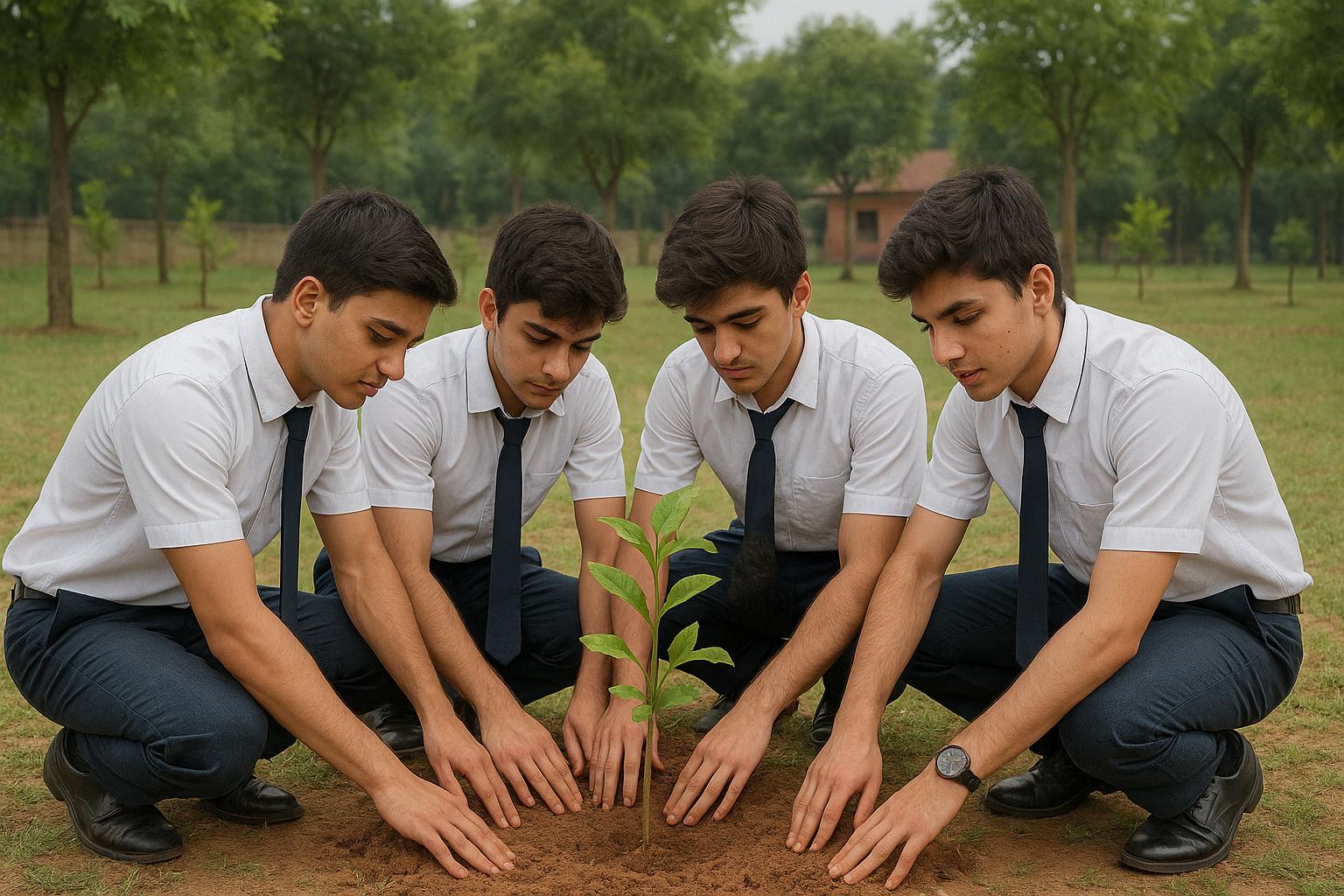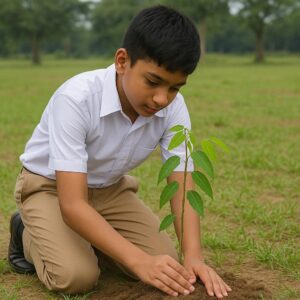This paragraph helps students in all grades. Whether you need a tree plantation paragraph for class 6,7, 8,9,10, SSC and HSC students. You can also make it concise as a paragraph 150 words or 250 words. Tree plantation is the process of planting young saplings in spots where they can grow into healthy, full‑grown trees. It matters because trees clean our air, fight climate change by storing carbon, prevent soil from washing away, conserve water, and provide habitats for birds and insects. Trees also cool our streets, brighten our parks, and boost our mood with their fresh, green beauty.

Tree Plantation Paragraph for Class 6 (100 words)
Tree plantation is the process of planting young saplings in spots where they can grow into healthy, full‑grown trees. It matters because trees clean our air, fight climate change by storing carbon, prevent soil from washing away, conserve water, and provide habitats for birds and insects. Trees also cool our streets, brighten our parks, and boost our mood with their fresh, green beauty.
Tree Plantation Paragraph for Class 7 (150 words)

Tree plantation is a simple yet powerful way to restore environmental balance and combat climate change. By planting saplings in homes, schools, and urban areas, communities absorb carbon dioxide, release oxygen, and improve air quality. Roots stabilize soil, prevent erosion, and support water infiltration, therefore reducing flood risks. A diverse tree canopy enhances biodiversity by providing habitat for birds and insects, sustaining ecosystem health. Strategic placement of green belts around cities moderates temperatures, lowers energy costs, and mitigates urban heat islands. In addition, tree-lined streets offer aesthetic appeal, mental health benefits, and recreational spaces for residents. Always water saplings during dry periods. To maximize impact, plant native species adapted to local climates and collaborate with local organizations for systematic plantation drives. Each sapling contributes to long-term ecological resilience, economic opportunities through forestry products, and community well-being. Thus, tree plantation remains an essential practice for sustainable development and healthier future generations.
Tree Plantation Paragraph for Class 8 (180 words)
Tree plantation is essential for sustaining life on Earth. Trees absorb carbon dioxide and release oxygen through photosynthesis, improving air quality. When saplings are planted along city streets or rural fields, they lower temperatures by providing shade and releasing moisture through transpiration. This natural cooling reduces the need for air conditioning and saves energy.
Without enough tree cover, urban areas become hotter and more polluted because there are fewer leaves to filter harmful particles from vehicles and factories. Deforestation also causes soil erosion and frequent flooding, as tree roots hold soil and absorb rainwater. This harms crops and weakens the environment.
Tree plantation helps restore nature and protect biodiversity. It gives homes to birds, insects, and animals, keeping ecosystems balanced. Involving students and families in planting activities builds awareness and a love for nature. Hands-on experience teaches better than books.
Green spaces from tree plantations also improve mental health by reducing stress and encouraging outdoor play. In both cities and villages, planting trees is a smart, low-cost way to fight climate change and build a sustainable future.
Tree Plantation Paragraph for Class 9 10 (200 words)
An effective tree plantation strategy is indispensable for combating environmental degradation and fostering sustainable development. By orchestrating systematic planting campaigns, schools and community groups can contribute to the proliferation of verdant landscapes that ameliorate air quality and sequester atmospheric carbon dioxide. Moreover, selecting indigenous species ensures ecological compatibility and enhances native biodiversity by providing suitable habitats for local fauna. Planting saplings during the fall or early spring maximizes root establishment before extreme temperature fluctuations, thereby increasing survival rates and long‑term growth prospects. Formal planning must encompass soil analysis, appropriate spacing, and post‑planting maintenance, such as mulching and periodic irrigation, to guarantee sapling resilience against environmental stressors. Therefore, integrating arboriculture principles with community education initiatives engenders a sense of ecological stewardship and empowers participants with practical horticultural knowledge. In addition to mitigating climate change, robust tree cover attenuates urban noise pollution and provides aesthetic and recreational amenities for citizens. Advanced monitoring techniques, such as geotagging and growth assessment surveys, enable coordinators to evaluate sapling survival rates and inform adaptive management strategies. Furthermore, documenting the plantation process through digital platforms enhances transparency and facilitates future replication of successful models across diverse communities. Ultimately, the synergy between scientific methodology and community engagement transforms tree plantation from a mere activity into a transformative endeavor that underpins ecological resilience and social well‑being.
Tree Plantation Paragraph for SSC (250 words)

Tree plantation is a meaningful and necessary practice that directly supports environmental health, biodiversity, and sustainable living. Trees play a crucial role in absorbing carbon dioxide and releasing oxygen, making the air cleaner and more breathable. With increasing levels of pollution and climate change, tree plantation is a natural solution to combat global warming. Trees provide shade, reduce noise pollution, and cool urban areas by lowering surrounding temperatures. Their roots hold soil in place, reducing the risk of erosion, landslides, and floods.
Moreover, trees serve as habitats for birds, insects, and animals, thus supporting biodiversity. Many trees offer fruits, timber, and medicinal benefits, adding to economic development. Planting native species helps preserve the ecological balance and improves survival rates. Personally, I chose to plant a guava tree in our backyard because it offers both fruit and shade, and it reminds me of the importance of caring for nature.
Tree plantation also has mental health benefits. Green spaces reduce stress, improve focus, and offer spaces for recreation and relaxation. Schools and communities should organize regular plantation drives, and every citizen should actively take part in them. Governments must also enforce strict policies to protect forests and encourage tree growth.
In conclusion, planting trees is not only an environmental duty but a social responsibility. A well-planned tree plantation effort can transform our cities, villages, and even individual homes into green, fresh, and hopeful spaces. We must act today to ensure a healthier, greener tomorrow.
Tree Plantation Paragraph for HSC (300 words)
Tree plantation is an essential activity for preserving the environment and ensuring long-term ecological sustainability. Trees provide multiple benefits, not only improving air quality but also contributing to soil conservation and climate regulation. By absorbing carbon dioxide and releasing oxygen, trees help reduce the effects of global warming, making them critical in the fight against climate change. In addition, the presence of trees in urban areas can significantly reduce the urban heat island effect, which causes higher temperatures due to concrete and a lack of vegetation. This cooling effect helps lower energy consumption by reducing the need for air conditioning, thereby saving money and reducing emissions.
Furthermore, trees enhance biodiversity by creating habitats for various species, including birds, insects, and mammals. This promotes a balanced ecosystem and supports the survival of essential pollinators. The roots of trees help prevent soil erosion by stabilizing the ground, especially in hilly areas, where they prevent landslides and flooding. Additionally, trees play an important role in water conservation by reducing surface runoff and increasing groundwater recharge.
Planting trees also provides socio-economic benefits, such as timber, fruits, and medicinal resources. Many communities around the world depend on trees for their livelihoods. By planting native species, we not only protect local ecosystems but also ensure that trees thrive in their natural environments, offering the maximum benefit. To maximize the impact of tree plantation efforts, it is crucial to engage communities, governments, and organizations in large-scale initiatives and to ensure proper care and maintenance of planted trees.
In conclusion, the importance of tree plantation cannot be overstated. It is a powerful, long-term solution that addresses environmental challenges while enhancing the quality of life for all.
Quick Writing Tips for All Classes
To write a strong and effective paragraph on any topic, start by brainstorming three key points. For example, if you’re writing about tree plantation, think about environmental benefits, personal experience, and community impact. This helps organize your thoughts clearly and ensures your paragraph has a logical flow. Use vivid and descriptive words like green, fresh, and hopeful to bring your writing to life. These words create a positive and engaging tone, making your paragraph more interesting to read. Also, don’t forget to check your spelling and punctuation carefully. Even one small mistake can affect the quality and clarity of your writing. Whether you’re writing for Class 6 or HSC level, these simple steps can help improve your writing and make your message stronger. Good planning, strong vocabulary, and clean grammar are the keys to success. Practice regularly, and soon, writing great paragraphs will become a natural skill.
Tree Plantation Paragraph – FAQ
- Why is tree plantation important in Bangladesh?
Answer: Tree plantation is crucial in Bangladesh because it helps prevent natural disasters like floods, cyclones, and erosion. Trees absorb carbon dioxide, purify the air, and maintain ecological balance, which is especially important in a densely populated and climate-vulnerable country like Bangladesh.
- What types of trees are suitable for planting in Bangladesh?
Answer: Trees like neem, rain tree, mango, jackfruit, mahogany, banyan, and native species like sundari (from the Sundarbans) are well-suited for the Bangladeshi climate and soil.
- When is the best time to plant trees in Bangladesh?
Answer: The best time for tree plantation in Bangladesh is during the monsoon season (June to August) because the soil stays moist, which helps young trees establish roots and grow quickly.
- Can trees be planted in cities in Bangladesh?
Answer: Yes, urban areas can benefit greatly from tree planting. Trees can be planted on rooftops, in pots on balconies, and along roadsides to reduce air pollution and improve urban life quality.
- How does tree plantation help control floods in Bangladesh?
Answer: Tree roots absorb rainwater and reduce surface runoff, which helps prevent sudden flooding. In flood-prone areas like northern and coastal Bangladesh, trees act as natural barriers.
- What role do trees play in Bangladesh’s fight against climate change?
Answer: Trees absorb greenhouse gases and regulate temperature. In Bangladesh, where climate change is causing more extreme weather, trees are a natural defense against its impacts.
- Are there any government or NGO tree plantation programs in Bangladesh?
Answer: Yes, various government bodies like the Department of Forest and NGOs like BRAC and Prokriti O Jibon Foundation organize tree plantation campaigns across the country.
- How does deforestation affect Bangladesh?
Answer: Deforestation causes soil erosion, loss of biodiversity, and increases the risk of natural disasters. In areas like the Chittagong Hill Tracts and coastal regions, it’s a major environmental threat.
- Can students participate in tree plantation programs?
Answer: Absolutely! Many schools and colleges in Bangladesh organize tree plantation drives. Students can also join community or local youth groups to plant and take care of trees.
- How can individuals help promote tree plantation in Bangladesh?
Answer: Individuals can start by planting trees in their homes, schools, or communities. Raising awareness on social media, supporting green initiatives, and donating to plantation projects also make a big impact.
Author
Archives

Tree Plantation Paragraph: A Simple Guide for Students
This paragraph helps students in all grades. Whether you need a tree plantation paragraph for class 6,7, 8,9,10, SSC and HSC students. You can also…